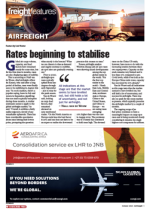Global air cargo volume, capacity, and load factors have remained steady for some time, but for the first time in months, rates are also displaying signs of stability.This is according to Niall van de Wouw, chief airfreight officer for Xeneta, who said after a long period of decline, rates were finally seen to be stabilising in August this year. “In stock markets, there's a popular saying, leave in July and return in September, signifying that not much typically transpires during those months. A similar sentiment seems to apply to the global airfreight market," he said. "Overall, it exhibits a fairly stable trajectory, devoid of any remarkable upheavals. There has been considerable speculation about rates hitting their lowest point, prompting the question: what exactly is the bottom? What we can discern is that as demand and supply continue to stabilise, air spot rates are gradually evening out ."Prior to 2020, airfreight spot rates typically spiked from late August through early September – just in time for the peak season. Van de Wouw said, looking at cargo load factors, they remained elevated on Asia westbound trades. “On the North America to Europe trade lane the load factor is 37% and one does not have to be an expert to realise the downward pressure this creates on rates.”Xeneta airfreight analyst Wenwen Zhang said air spot rates were showing mixed developments among the top global trades in the world. “For the four top trades in the world – North East Asia, Middle East and Central Asia, northeast Asia to Europe, China to the United States, and China to Europe – we are seeing rates averaging 55% higher than was the case in August 2019. The persistent war in Ukraine has continued to hold rates high. The elevated rates on the China-US trade, however, have more to do with the increasing tension between these two superpowers. Capacity on this trade remains very limited and is less than 10% compared to pre-Covid levels, while if we look at the Europe-China trade route, capacity has recovered by 50% already.”Van de Wouw said all indications at this stage were that the market seemed to have levelled out, but still held a lot of uncertainty, and not just for airfreight. There was also no peak for the ocean market at present, which typically precedes the airfreight market by a couple of months.The ongoing surge of jet fuel prices continues to have a meaningful impact on cargo spot rates and is being monitored closely considering it remains the single highest cost component for airlines.

